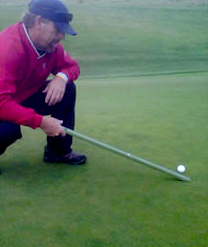 Over the past several weeks I’ve had opportunities to meet with several golf course superintendents and the one topic of discussion that was continually discussed was green speed. What is an ideal green speed and what are golf course superintendents doing to provide the “ideal” green speed?
Over the past several weeks I’ve had opportunities to meet with several golf course superintendents and the one topic of discussion that was continually discussed was green speed. What is an ideal green speed and what are golf course superintendents doing to provide the “ideal” green speed?
What is an “ideal” green speed? There is no correct answer for this question. It is entirely up to the Club or superintendent to determine what green speed they desire. Based on my discussions the green speeds ranged from 9 to 12 as measured by a stimpmeter.
A stimpmeter is an aluminum bar, 36″ long with a v-shape extending throughout the length of the bar. There is a hole at the end where the ball is placed. Locate a flat area of the green and then position the ball in the slot. The starting point is marked with a tee. Then raise the bar and then measure the distance from the tee to where the ball stopped rolling. Do this 3 times. All of the balls should not be more than 8 inches apart. Then place 2nd tee at the average distance and then do in the opposite direction. Measure and take the averages.
In the spring when temperatures are cooler and growth limited, greens are generally quicker. But when temperatures warm and growth becomes aggressive, greens will slow down. The same thing happens in the fall when temperatures lower, the greens will pick up speed.
Of course this also depends upon how the superintendent is managing the greens. Excess nitrogen fertility and overwatering will cause excessive growth and lessen the speed. Nitrogen and watering must be monitored very closely to maintain the adequate green speed.
Height of cut is a big factor affecting green speed. Generally the lower the height the faster the green speeds. But this doesn’t come without repercussions. The health of the turf is very weak at these heights and stress will be induced. The plant must be able to carry out photosynthesis and the lower the height the less amount of food the plant will manufacture and the outcome could potentially be starvation or disease invasion. Low mowing heights in the summer are not recommended. There was a large amount of turf loss in 2010 in the East because of the amount of stress placed on the plant during excessive hot and humid conditions.
Other factors affecting green speed include; hollow tine aeration to remove vegetative material and increase soil oxygen levels, verticutting and topdressing every 10 to 14 days to reduce grain and smooth the putting surfaces, spiking every 2 to 3 weeks to vent the greens and brushing the greens prior to mowing to remove the grain.
Another practice that has gained huge popularity is rolling the greens. This is being done from 2 to 6 times/week in conjunction with mowing. Research has shown that rolling does less damage than mowing.
Health of the turf is critical in determining the “ideal” green speed for your golf course.
